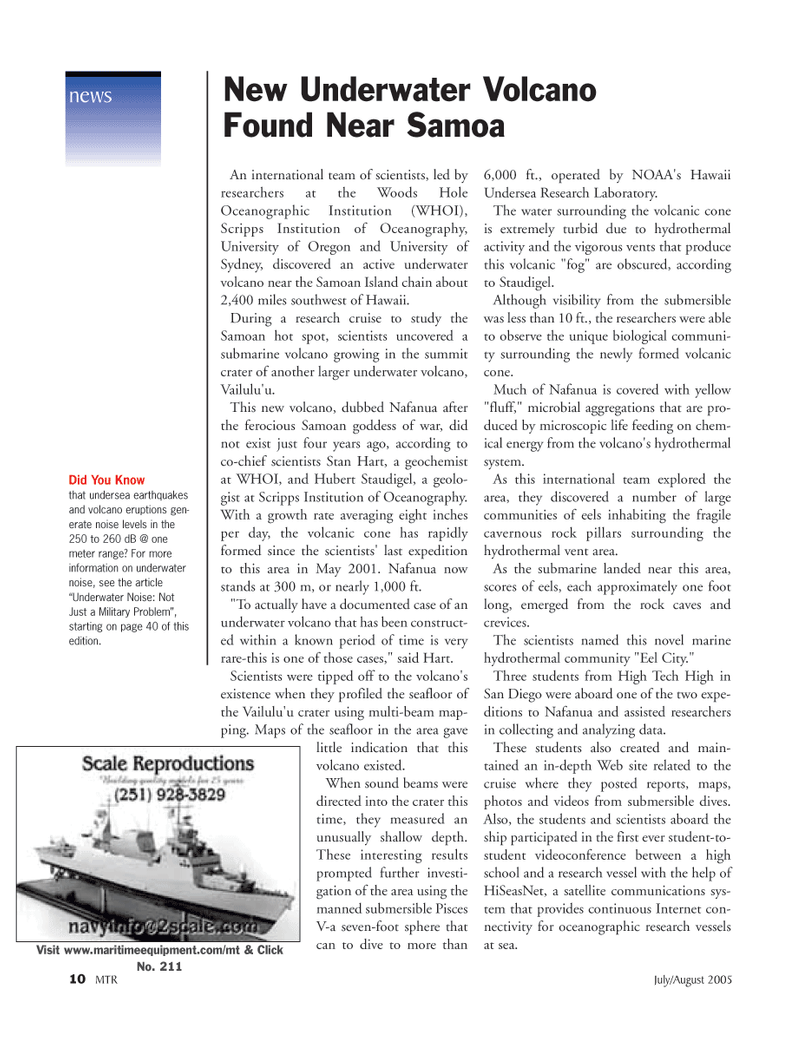
Page 9: of Marine Technology Magazine (July 2005)
Read this page in Pdf, Flash or Html5 edition of July 2005 Marine Technology Magazine
10 MTR July/August 2005
New Underwater Volcano
Found Near Samoa
An international team of scientists, led by researchers at the Woods Hole
Oceanographic Institution (WHOI),
Scripps Institution of Oceanography,
University of Oregon and University of
Sydney, discovered an active underwater volcano near the Samoan Island chain about 2,400 miles southwest of Hawaii.
During a research cruise to study the
Samoan hot spot, scientists uncovered a submarine volcano growing in the summit crater of another larger underwater volcano,
Vailulu'u.
This new volcano, dubbed Nafanua after the ferocious Samoan goddess of war, did not exist just four years ago, according to co-chief scientists Stan Hart, a geochemist at WHOI, and Hubert Staudigel, a geolo- gist at Scripps Institution of Oceanography.
With a growth rate averaging eight inches per day, the volcanic cone has rapidly formed since the scientists' last expedition to this area in May 2001. Nafanua now stands at 300 m, or nearly 1,000 ft. "To actually have a documented case of an underwater volcano that has been construct- ed within a known period of time is very rare-this is one of those cases," said Hart.
Scientists were tipped off to the volcano's existence when they profiled the seafloor of the Vailulu'u crater using multi-beam map- ping. Maps of the seafloor in the area gave little indication that this volcano existed.
When sound beams were directed into the crater this time, they measured an unusually shallow depth.
These interesting results prompted further investi- gation of the area using the manned submersible Pisces
V-a seven-foot sphere that can to dive to more than 6,000 ft., operated by NOAA's Hawaii
Undersea Research Laboratory.
The water surrounding the volcanic cone is extremely turbid due to hydrothermal activity and the vigorous vents that produce this volcanic "fog" are obscured, according to Staudigel.
Although visibility from the submersible was less than 10 ft., the researchers were able to observe the unique biological communi- ty surrounding the newly formed volcanic cone.
Much of Nafanua is covered with yellow "fluff," microbial aggregations that are pro- duced by microscopic life feeding on chem- ical energy from the volcano's hydrothermal system.
As this international team explored the area, they discovered a number of large communities of eels inhabiting the fragile cavernous rock pillars surrounding the hydrothermal vent area.
As the submarine landed near this area, scores of eels, each approximately one foot long, emerged from the rock caves and crevices.
The scientists named this novel marine hydrothermal community "Eel City."
Three students from High Tech High in
San Diego were aboard one of the two expe- ditions to Nafanua and assisted researchers in collecting and analyzing data.
These students also created and main- tained an in-depth Web site related to the cruise where they posted reports, maps, photos and videos from submersible dives.
Also, the students and scientists aboard the ship participated in the first ever student-to- student videoconference between a high school and a research vessel with the help of
HiSeasNet, a satellite communications sys- tem that provides continuous Internet con- nectivity for oceanographic research vessels at sea. news
Did You Know that undersea earthquakes and volcano eruptions gen- erate noise levels in the 250 to 260 dB @ one meter range? For more information on underwater noise, see the article “Underwater Noise: Not
Just a Military Problem”, starting on page 40 of this edition.
Visit www.maritimeequipment.com/mt & Click
No. 211
MTR#1 (1-16).qxd 7/19/2005 10:58 AM Page 12

 8
8

 10
10
